Mario & Luigi: Partners in Time presents multiple areas where improvements could have been made; nevertheless, none of its issues stop it from being a solid entry in the role-playing canon of the plumber
With the creation of the Mario & Luigi franchise, done through the Game Boy Advance’s excellent Superstar Saga, the Super Mario property was blessed with two different RPG series that, while sharing a whole lot of characteristics, also boast enough distinctions to justify their existence. Much like Paper Mario, the line of games that showcases the two popular brothers joining forces against evil powers is constructed on straightforward, fun, and interactive turn-based battles; ridiculously charming self-referential humor that takes advantage of the inherent lunacy present in a universe where mushrooms talk and mustachioed plumbers are unstoppable heroes; and light puzzle-solving moments that sprinkle some flavor onto the usually mundane exploration component of games of the sort.
However, where the Paper Mario games – at least in their first two incarnations – tend to achieve all of those feats through thick storytelling and the interaction between the starring character and his partners, Mario & Luigi does so supported by a sillier and more absurd brand of comedy as well as the strong cooperation displayed by its pair of protagonists.
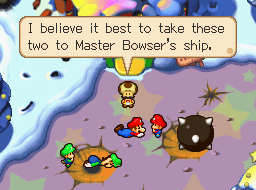
Considering the success of Superstar Saga, it is entirely unsurprising that – about two years after its release and with the coming of a new handheld system – the portable line of Mario RPGs ended up gaining a new entry in the form of Mario & Luigi: Partners in Time, published on the Nintendo DS. Likewise, for the same reason, there is nothing unexpected about how it is built on the strong foundation put in place by its predecessor.
Still, despite the natural similarities that emerge between both titles, Partners in Time does spend a considerable amount of effort trying to bring forth gameplay staples and storytelling quirks to call its own, and although none of those measures indisputably improve on what existed before them or provide a significant break from the formula, they certainly work towards making Partners in Time unique and enjoyable.
The first move the game executes towards finding its own personality comes in regards to its setting, for while Superstar Saga extracted much of its amusing oddity out of the curious Beanbean Kingdom, Partners in Time goes back to the good old Mushroom Kingdom. There, in the halls of Peach’s Castle, Professor E. Gadd is about to unveil his latest invention: a time machine.
Apparently unaware that journeys inside such an apparatus rarely lack danger and often lead to calamity, the princess volunteers to travel to the past. The machine, powered by the Cobalt Star, works as intended and Peach reaches an older version of her home; however, once it comes back to the present, the device’s door is flung open to reveal that a violent extraterrestrial is inside it and the princess as well as the the Cobalt Star are nowhere to be found.
After dealing with the creature, Mario and Luigi soon discover that the Mushroom Kingdom of the past has been invaded by a race of vicious purple aliens known as the Shroobs and that as soon as she stepped out of the machine, Peach was kidnapped by their leader. As time portals start appearing all around the castle, the brothers quickly set out to use each one of them to travel to a specific and enclosed location in the past and acquire assets that will be used in the rescuing process, a progression style that makes the game rather linear.
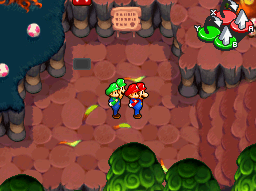
It is via that time-traveling quirk that Partners in Time unlocks its greatest gameplay feature, because as they visit the past, Mario and Luigi quickly stumble upon their younger selves, which will accompany them in their mission and – consequently – provide new mechanics both inside and outside battles. Yet, from a storytelling and gameplay perspective, it is arguable much of the potential found in the existence of distinct time periods goes to waste.
Surely, a great deal of hilarity ensues when characters bump into their past counterparts – the interactions between Bowser and Baby Bowser as well as those between two deeply worried Toadsworths and an infant Princess Peach are endlessly funny. But the game never really dabbles into how actions in the past have ramifications in the relative future. The Shroob invasion and widespread destruction that is seen in the Mushroom Kingdom of old does not make the slightest dent in the present, and at no point does the game make Mario and Luigi travel between two periods within the same region in order to clear a time-related puzzle, as all locations of the Mushroom Kingdom that are visited – with the exception of the castle, which serves as the hub in the present and the final Shroob stronghold in the past – are only seen in their more ancient format.
As a consequence of that simplistic approach, Partners in Time leaves some stones unturned. In gameplay, the appearance of Baby Mario and Baby Luigi does bring new twists to the table, and they successfully separate this second quest from Superstar Saga; however, it is impossible not to think that the gap between both titles could have been bigger if time had a more considerable role in the adventure.
In plot, meanwhile, the story comes off as undercooked. A couple of interesting twists lie in wait, but Partners in Time is generally thin in dialogues and developments. And that trait sometimes causes its segments to feel as mere treks towards the collection of one of the pieces of the Cobalt Star – which is the asset that must be employed in order to defeat the Shroobs – when they could have been more engaging had they found a better balance between script and gameplay.
That smaller amount of dialogues may come as a disappointment to those who fell in love with the outlandish exchanges that permeated much of Superstar Saga; after all, they were that game’s largest source of humor. In spite of that characteristic, though, Partners in Time is not lacking in laughter; it just chooses to generate these outbursts via a slightly different path than the one followed by its prequel. Rather than betting on conversation, Partners in Time bets on animation, as Mario and Luigi’s quest is filled with small cutscenes that soar towards the comical whilst making use of the extra hardware power of the Nintendo DS.
On this particular front, the lighter writing works wonders, not only because the game sports excellent visuals and fluid movements by the polished sprites, but also due to how its lovely short cinematics do a very good job in exploring the personality of its heroes and supporting characters alike. And a lot of the credit for that charm must go to the title’s sound, because even if – unfortunately – its tunes are a bit lackluster, the same does not apply to its effects and, especially, the gibberish Italian and other humorous voiced reactions uttered by Mario, Luigi, and the babies.
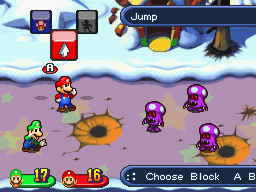
When the occasional lack of purpose that stems from a weak plot development is discounted, the gameplay of Partners in Time stands quite solidly. Giving the babies a piggyback ride, Mario and Luigi will go through varied scenarios; do some straightforward exploration, which is supported by the constant presence of a detailed map on the top screen; solve simple puzzles; and engage in battles to earn experience points and level up.
As it happened in Superstar Saga, the characters move as a unit and while the A button causes Mario to perform a certain action, such as jumping, the B button has the same effect on Luigi, with the shoulder keys being used to switch between the small amount of movements they can perform. The difference is that while in Superstar Saga it was up to Mario and Luigi to execute crazy maneuvers to surpass the obstacles standing in their way, as it happened when the latter climbed on the back of the former so they could spin wildly to float over large gaps, in Partners in Time the protagonists have – in addition to skills of their own – the help of the babies, who can be placed on the floor so they can move around independently.
The babies can be thrown onto ledges that are too high for the jumping ability of the titular heroes or sneak into holes their older versions would never be able to enter. Moreover, they can bury themselves into the ground, be flattened like pancakes, and be sent soaring into the air with the help of Mario and Luigi. Without exception, all of those moves are easy to perform: Baby Mario and Baby Luigi’s actions are controlled – respectively – with the X and Y buttons, and switching between the older and younger pair is simply a matter of pressing a key that corresponds to one of their members.
Most importantly, these actions pave the way to gameplay scenarios that did not exist in Superstar Saga. The highlight of the bunch appears when the babies get to places, such as tight caves, that their older selves cannot access. In those cases, taking advantage of what the Nintendo DS has to offer, the toddlers will appear on the top screen while Mario and Luigi will be kept on the bottom one, and sometimes the duos will be forced to work together and perform synchronized actions so they can proceed, like when Mario and Luigi need to hit blocks that will – in turn – temporarily light the way in the dark room where the babies are. Truth be told, these segments are never clever to an astounding degree, and they can be solved quite easily most of the times. However, they are well-designed and add nice twists to the exploration.
In battles, the babies also play a considerable role, albeit not as big as the one they have out in the field. It goes without saying that, like Mario and Luigi, they can initiate combats when alone, and they have at their disposal pretty much the same array of actions as their older selves, being able to jump onto enemies, hit them with a hammer, use all sorts of healing items, and flee. When they are strapped to the back of Mario and Luigi, though, they will give players the option to, by pressing the button that is relative to the baby at the right time, power up the main heroes’ jumping and hammering attacks.
In fact, as a whole, the turn-based combat of Partners in Time is, like that of its prequel, extremely reliant on timing: all moves gain a boost if gamers press the button corresponding to the character that is attacking when the blow is about to hit; and, as a highlight, all attacks performed by enemies can be dodged if players react appropriately, with some moves even leaving the door open for counterattacks if the timing of the button press is extremely precise.
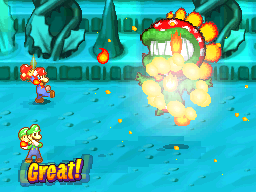
That implementation turns battles into a delight. Their action-focused ways force players to keep their eyes glued to the screen both when attacking and defending. Furthermore, given foes can drain the HP of the heroes quite quickly if all of their moves land successfully, learning their patterns and how to avoid their moves with some consistency is critical to surviving.
Partners in Time is, especially during the first half of its fifteen hours of gameplay, not too challenging of a quest, meaning that getting the hang of defending against the varied set of attacks of the equally varied cast of foes is not too hard. However, as the game advances and bosses get tougher and enemies trickier, players will be tested, because the cues that indicate when the attack is coming and – particularly – which brother it will be used against get ever subtler and the time to react much smaller. And although regular foes never rise to truly daunting obstacles, bosses – especially towards the end of the game – will pose quite a challenge thanks to how their elevated HP can make some battles last for a while.
Out of all facets of Partners in Time’s battle system, nowhere is that unique inclination towards action as noticeable as in the protagonists’ main form of attack: the Bros. Items. Purchasable in stores and found around the overworld, they require the cooperation of either Mario and Luigi or of all characters in order to deliver mighty blows to foes. With ten variations available, once used, they trigger animations that dare players to – quickly and timely – press the button of the character that is about to attack so that the move gets progressively stronger or the chain of hits continues.
The copy flower, for example, creates multiple clones of the characters and, as they run into the screen, gamers have to press the button corresponding to the hero that is about to jump on the enemy; while with the green shell, a baby will hop onto it and Mario and Luigi will kick it around so that it bounces off the foe continuously until one of them misses. These items are entertaining to use and learning how to squeeze a lot out of them is, like dodging incoming attacks, a major part not only of the fun that can be found in the battle system, but also of the achievement of victory against the game’s hardest bosses.
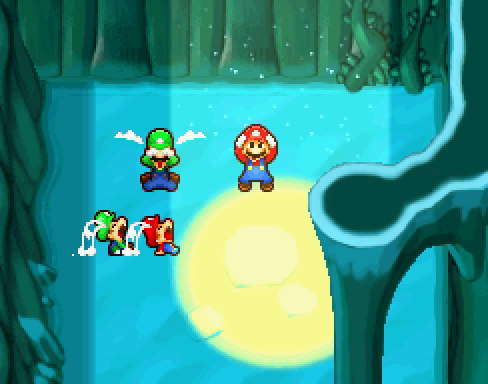
There are, of course, a number of areas where Mario & Luigi: Partners in Time could be better. A stronger and thicker script would give more purpose to some of its segments; a fully connected world, like the one from Superstar Saga, could have brought forth a bigger sense of freedom and worked far better than the linear portal-based traveling it employs; and the time-traveling quirk out of which it extracts its greatest new mechanic, the presence of Baby Mario and Baby Luigi, is visibly underused, as it fails to bring any other considerable ramifications in plot as well as in gameplay.
Nevertheless, an evaluation of its components reveals a game that is strong, as its humor is undeniably sharp, its animations are lovely, its battle system is highly entertaining, and the puzzles that appear as the heroes explore the world are simple yet fun. Due to that, although it falls short of the greatness achieved by some of the other entries of the series, Mario & Luigi: Partners in Time is a very solid role-playing outing by the plumber.
